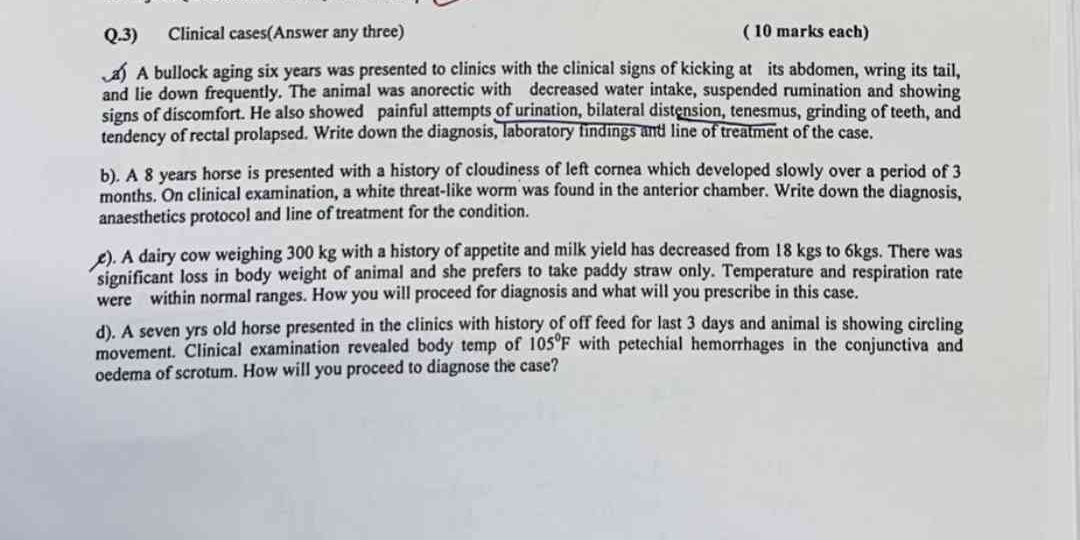Clinical cases (Answer any three) a) A bullock aging six years was presented to clinics with the clinical signs of kicking at its abdomen, wringing its tail, and lying down frequen... Clinical cases (Answer any three) a) A bullock aging six years was presented to clinics with the clinical signs of kicking at its abdomen, wringing its tail, and lying down frequently. The animal was anorectic with decreased water intake, suspended rumination, and showing signs of discomfort. He also showed painful attempts of urination, bilateral distension, tenesmus, grinding of teeth, and tendency of rectal prolapse. Write down the diagnosis, laboratory findings, and line of treatment of the case. b) A 8 years horse is presented with a history of cloudiness of left cornea which developed slowly over a period of 3 months. On clinical examination, a white threat-like worm was found in the anterior chamber. Write down the diagnosis, anaesthetics protocol and line of treatment for the condition. c) A dairy cow weighing 300 kg with a history of appetite and milk yield has decreased from 18 kgs to 6 kgs. There was significant loss in body weight of animal and she prefers to take paddy straw only. Temperature and respiration rate were within normal ranges. How will you proceed for diagnosis and what will you prescribe in this case? d) A seven years old horse presented in the clinics with history of off feed for last 3 days and animal is showing circling movement. Clinical examination revealed body temp of 105°F with petechial hemorrhages in the conjunctiva and oedema of scrotum. How will you proceed to diagnose the case?

Understand the Problem
The question is asking for the diagnosis, treatment plans, and procedures for four different clinical cases involving animals, specifically a bullock, horse, and cow. It requires a thorough understanding of veterinary medicine to identify conditions and recommend treatments.
Answer
a) Obstructive urolithiasis, b) Onchocerciasis, c) Ketosis, d) Equine Viral Arteritis.
a) Diagnosis: Obstructive urolithiasis. Laboratory findings: Elevated BUN and creatinine; urine analysis may reveal crystals. Treatment: Surgical intervention like urethrostomy, catheterization, and dietary management to prevent recurrence.
b) Diagnosis: Onchocerciasis (Equine ocular form). Anaesthetics: Local anesthesia for the eye and sedation to remove the worm. Treatment: Surgical removal of the worm and systemic ivermectin administration.
c) Diagnosis: Ketosis. Proceed with urine or milk ketone testing. Prescription: Administration of propylene glycol, glucose drips, and dietary adjustments.
d) Diagnosis: Possibly Equine Viral Arteritis or other infectious diseases. Proceed with blood tests and viral culture. Look for supportive care and targeted antiviral therapy if confirmed.
Answer for screen readers
a) Diagnosis: Obstructive urolithiasis. Laboratory findings: Elevated BUN and creatinine; urine analysis may reveal crystals. Treatment: Surgical intervention like urethrostomy, catheterization, and dietary management to prevent recurrence.
b) Diagnosis: Onchocerciasis (Equine ocular form). Anaesthetics: Local anesthesia for the eye and sedation to remove the worm. Treatment: Surgical removal of the worm and systemic ivermectin administration.
c) Diagnosis: Ketosis. Proceed with urine or milk ketone testing. Prescription: Administration of propylene glycol, glucose drips, and dietary adjustments.
d) Diagnosis: Possibly Equine Viral Arteritis or other infectious diseases. Proceed with blood tests and viral culture. Look for supportive care and targeted antiviral therapy if confirmed.
More Information
Obstructive urolithiasis is common in male ruminants due to their anatomical structure. Ketosis in dairy cows is associated with energy deficiency, leading to metabolic disturbances. Onchocerciasis in horses is caused by filarial worms, affecting the eyes.
Tips
A common mistake is overlooking dietary factors in ruminant cases; adjusting diet is crucial in both prevention and treatment.
Sources
- Obstructive urolithiasis in ruminants – A review - ResearchGate - researchgate.net
- Review on Practical Guidance of Veterinary Clinical Diagnostic - veteringroup.us
AI-generated content may contain errors. Please verify critical information